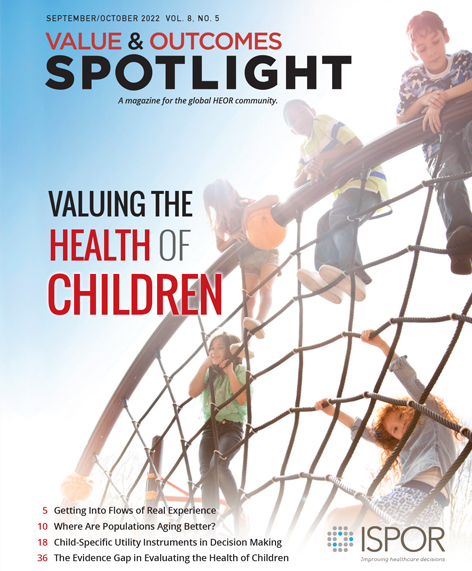Getting Into Flows of Real Experience: A Radical New Framework for Creating Health and Well-Being
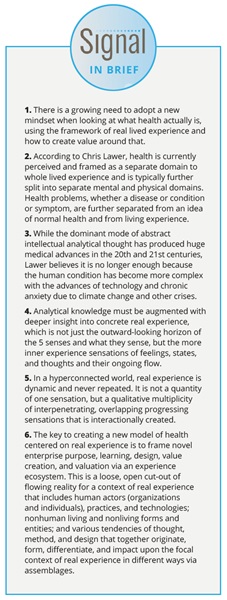
What is health? If you believe you know, Chris Lawer, MA, MPhil (Oxford, England, United Kingdom), wants you to think again. As founder of Umio and the Real Experience Flow Creation® framework, his work asks us to put health back into—not separate from—real lived experience and to see it as dynamic, interactional, creational, and as a continuous flow.
Lawer says until now, the dominant way of considering health has been “intellectual analytical.” In this mode of thinking, health is separated from lived experience and is then typically split into 2 subdomains, mental and physical. For any problem (a disease condition, illness, and its symptoms), it is further abstracted to form a distinct object of intellectual enquiry.
“The object of concern is separated from an idea of normal health and from lived experience,” Lawer states. “Our gaze is, in effect, 3 times removed from the actual experience of individual persons.”
Addressing the Problem
These now-abstract health problems are then subjected to the use of symbols and variables to record, analyze, measure, and quantify the matter of concern. “We fix it in our gaze and in time to determine its properties of size, scale, and severity to tell us what it is and what we should do about it,” Lawer says. “We then diagnose it, label it to create and share meaning, and to decide whether and how to deal with it. And then we use the same methods to assess the effect of any new or existing intervention on the properties of the problem.”
Next, Lawer explains, comes the application of logic, reason, and mathematics with outcomes, endpoints, and score systems. Together, these are used to produce the correlations, comparisons, and predictions needed to inform evaluations, choices, and actions in healthcare practice. “This dominant mode of abstract intellectual analytical thought fixes in time discrete parts of whole experience in an objectified model of health, functioning, and being,” he says. “While this mode of thought has produced huge medical advances in the 20th and 21st centuries, my position is that on its own, it’s no longer enough.”
According to Lawer, as the human condition has become more complex—from emergence of new beyond category group identities, the rise of the digital embodied mind, and new hidden forces of health inequity—health economics and outcomes research (HEOR) experts need to augment their analytical knowledge with deeper insight into concrete real experience.
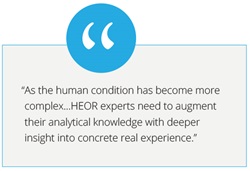 Mapping Real Experience
Mapping Real Experience
How should real experience be mapped? Lawer describes the 5 essential dimensions of real experience as: (1) interiority, (2) flow, (3) qualitative progression, (4) interactional creation, and (5) a reality of collective flows in the world.
Lawer defines the interiority of real experience as not just the “outward-looking horizon” of what the 5 senses experience, but also the inner experience of sensations, feelings, and thoughts. “So, in this perspective, we fold in health (mental and physical) and any problems of disease or illness into interior real experience itself.”
For the second dimension, flow, Lawer maintains that real experience is always becoming or flowing. “By flow, I mean that time in experience is ceaselessly passing and also irreversible,” he says. “The future is always on its way to the present, and the present moment is always setting into the past.” This means in real experience nothing is ever stable or stays the same.
The third dimension of real experience, qualitative progression, is not a quantity of sensations going up and down a scale, but a qualitative multiplicity of interpenetrating, overlapping progressing sensations, which Lawer equates to the notes that make up a song. “We don’t hear just a single note, we hear notes in their interrelation or togetherness, forming a whole as the song passes,” he says.
Lawer explains that someone with chronic pain does not just experience a singular sensation of pain, which they are often told to score from 1 to 10. “Rather, we feel an interpenetrating set of progressing sensations,” he says. Additionally, the present experience is shaped not only by memory of past experiences, but also by where the person is, what they need or would like to do—all “entangled in relations of forces producing different interpenetrating sensations.”
For the fourth dimension, interactional creation, Lawer says real experience is not produced in the mind or computer, separate from our real-world encounters. “Rather, it’s created, enriched, and diminished via our interactions, encounters, and events that we have in our world.”
And as for the fifth dimension of real experience, a reality of collective flows, we should consider how there are similar often chronic real experiences shared by many people in the world. “They include real experiences with bodily diseases such as pain, mental health real experiences such as depression, and more social kinds of dis-ease experiences such as loneliness,” Lawer says. “In any single context, these can share certain origins, forces, conditions, and capacities as well as observable consequences.”
The problem is that all these 5 essential dimensions of real experience escape our dominant empirical intellectual analytical mode. “Dynamics, movement, and flow are evacuated by analytical knowledge,” Lawer says. “We hold experiences stable and therefore miss the unstable flowing nature of actual reality. Our tendencies of thought and method suppress access to the real, and lead to only a superficial knowing of experience. Our gaze does not see the continuous flows of multiplicities of sensations, feelings, and thoughts, forming concrete and often similar real experiences in a world.”
To create an alternative, radical empiricism of health means starting with a new model of real experience—”one that is a dynamic, interior, flowing, becoming, and interactionally created via human events and encounters. And at the center of which are the core generative material of experience,” Lawer says. “These are the sensations or affects we have, as well as the capacities we desire to affect and be affected in order to enjoy the valued experiences we need or desire.”
Lawer says these aspects of real experience can be organized into 4 domains: (1) social/cultural, (2) material/spatial, (3) bodily/motor, and (4) perceptual/cognitive. Around this can be set a wider frame, which he calls a “focal real experience environment”— all of which supports a more substantive model of the origins, formation, and differentiation of health, disease, and illness within real experience, which Lawer describes as “a developmental model of health that goes way beyond the more baseline, functioning, and essential view of normal health.”
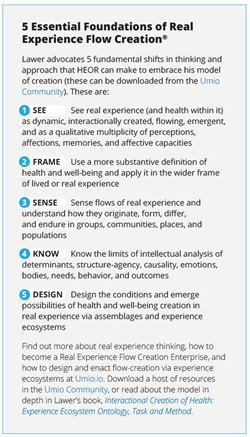 Real Experience and Chronic Pain
Real Experience and Chronic Pain
For any real experience context, which Lawer demonstrates using his extensive work in chronic pain, he first defines the poles of the most positive and negative qualities, capacities, expressions, and desires for the context. The poles are then used to research and determine different states of real experience, their distribution, and the movements or transitions between them on a line of deterioration and a line of recovery between the poles for a population of place, which Lawer calls an assemblage.
“An assemblage is kind of like a machine that produces and differentiates real experiences. Greater than the sum of its parts of social determinants, human and nonhuman actors, tendencies, events, affects, capacities, and material things like devices, drugs, and digital technologies,” Lawer says. “An assemblage generates a particular enduring quality, content, and expression of real experience within a single context such as chronic pain. For any focal context, we can discover and map assemblages of real experience that exist around the poles of most positive and most negative experience, all within a real experience ecosystem environment.”
This was the radical thinking and approach used to map assemblages for the diverse chronic-pain real experiences of 400,000 persons in Northern Ireland. Lawer and his team identified 6 previously hidden contingent relational assemblages of real experience, each with different qualities, expressions, and capacities of chronic pain along with the transitions between them. With the assesmblages mapped, public health and healthcare actors have a completely new view of difference within a disease context and a new path towards value creation via assemblage-based policy design, assessment, and resource planning.
With his models of real experience, experience ecosystems, and assemblages, Lawer has developed “an entire end-to-end real experience (with health, disease, illness, dis-ease) learning, design, and creation framework and process to support any enterprise to pursue real experience impact in any context or place.”
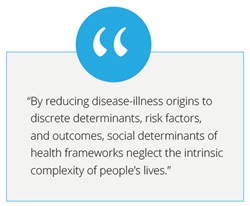 Social Determinants of Health and the Limitations of Current Frameworks
Social Determinants of Health and the Limitations of Current Frameworks
While Lawer agrees that social determinants of health should be part of health outcomes evaluation, he disagrees with the linear conceptual frameworks used to evaluate the impact of social determinants of health and points out the consequences that arise from their limitations. “It really comes back to my thinking on the intellectual analytical or abstract mode of thought that dominates the health sciences,” he explains. “We apply this in the same way to social determinants: we trace a line of causality between determinant effects and outcomes, and then the actions, the practices, or policies we launch on the back of that connection. Essentially, they all start from the same objectification of health as a separate domain and as a biomedical phenomenon within individual persons. This dominant narrative of upstream/downstream, I don’t think particularly helps.”
As he points out in a paper, “Addressing the Social Determinants of Health via Assemblages of Real Experience”, “rarely do individual determinants have a direct causal correlation with discrete identifiable health outcomes, even within narrowly defined places, groups, or populations.” While dirty air in high-traffic urban areas does have a direct correlation to childhood asthma, more often, “an entanglement of multiple contingent determinants” creates disease and generates health inequities.
“Any framework and analysis of health inequities must then abandon the idea of discrete determinant risk factors, where each risk originates and bears a direct line of causality to an (unequal) outcome,” Lawer writes. “Rather, the upstream-downstream analogy used in common social determinants of health narrative is better characterized as a mangrove swamp of interflowing, connected roots, puddles, bogs, streams, and dry land patches whose interactions produce ongoing conditions of multideterminant risk formation. Even in the case of environmentally induced childhood asthma, the determinant is not just the harmful particulate matter in the air (the single risk factor) but also the human actions, indecisions, motives, ignorance, exploitation, and discriminations that put and have kept them there. Any upstream determinant then is rarely just a single cause; it is an entanglement of meaning, matter, ideas, and tendencies as well as force, and is always connected with other determinants.”
Another problem is the huge number of social contexts and risk factors now included in social determinants thinking, Lawer says. “Its field has widened to such an extent that there’s almost nothing left out, nothing outside of collective life that does not mediate our health-disease status in some way. Every week, we see in the newspaper that such-and-such risk has been traced to such-and-such an outcome.”
Most of all, however, Lawer argues that social determinants thinking simply misses real experience. “Fundamentally, by reducing disease-illness origins to discrete determinants, risk factors, and outcomes, social determinants of health frameworks neglect the intrinsic complexity of people’s lives. They fail to see and understand how important differences in real experience play out across and within categories of determinants and social context. Consequently, they are unable to produce the deep insights needed to guide actions that reduce health inequalities and disparities on a sustained basis.”
Enter the Nautilus
In Umio’s logo and branding, Lawer uses the nautilus as an analogy for a new model of value co-creation or rather, flow-creation. “The nautilus propels itself by bringing in flows of water into its body and to maneuver its direction forward. Its entire existence is an interactional one in relation to the flows of water it harnesses to enact its movements.”
Just as the nautilus intuitively understands how to use flows to propel itself and its interactions in its environment, Lawer wants enlightened enterprises to harness Real Experience Flow Creation® to not only learn about flows of real experience, but also to design, create, and emerge them. “A Real Experience Flow Creation Enterprise becomes adept at understanding the flow nature of real experience and then harnesses this insight in its product, service, and platform design, its stakeholder relations, and in the interactional creation of health and well-being. All may be enacted via an experience ecosystem environment where multiple stakeholders work with shared purpose to create desired, valued real experiences. All embrace real experiences, assemblages, and flow-creation as their primary vehicles of value creation and valuation in the pursuit of real impact,” Lawer says.
ISPOR’s Signal Series
This article was developed from ISPOR’s June 21 Signal episode, “The Real Experience Revolution®: Towards a New Empiricism of Health,” in which ISPOR welcomed Lawer and Daniel J. Pesut, PhD, RN, Emeritus Professor of Nursing at the University of Minnesota, for a conversation around the implications of Lawer’s thinking and method for health economics, value creation/valuation, and outcomes for nursing and other key healthcare professions, and for creating health and preventing/addressing disease from the perspective of whole real experience via trans-disciplinary models of purpose and action.
ISPOR started the Signal program to bring a broader understanding of innovation (beyond product innovation), with the goal of putting these issues front and center for the health economics and outcomes research (HEOR) community. Each episode in a series is a self-contained installment and not dependent on the previous episodes; however, all are connected by an intent to look at the concept of innovation and experience with it from different groups of healthcare stakeholders, building foresight into how these innovations might impact healthcare decision making in the next decade.
Another Signal episode, “New Insights Into Advanced Therapy Medicinal Product Valuation and Outcomes-Based Pricing Experience,” was held on September 27, and focused on the Danish experience with advanced therapy medicinal product-valuation approach and development of an innovative outcomes-based pricing agreement between pharma and payers. The goals of this episode were to generate insight into the practicalities of stakeholder involvement and data requirements, and to gather overall learnings from the outcomes-based pricing agreement experience from a multistakeholder perspective. We will cover this episode more in-depth in a future issue of Value & Outcomes Spotlight.

